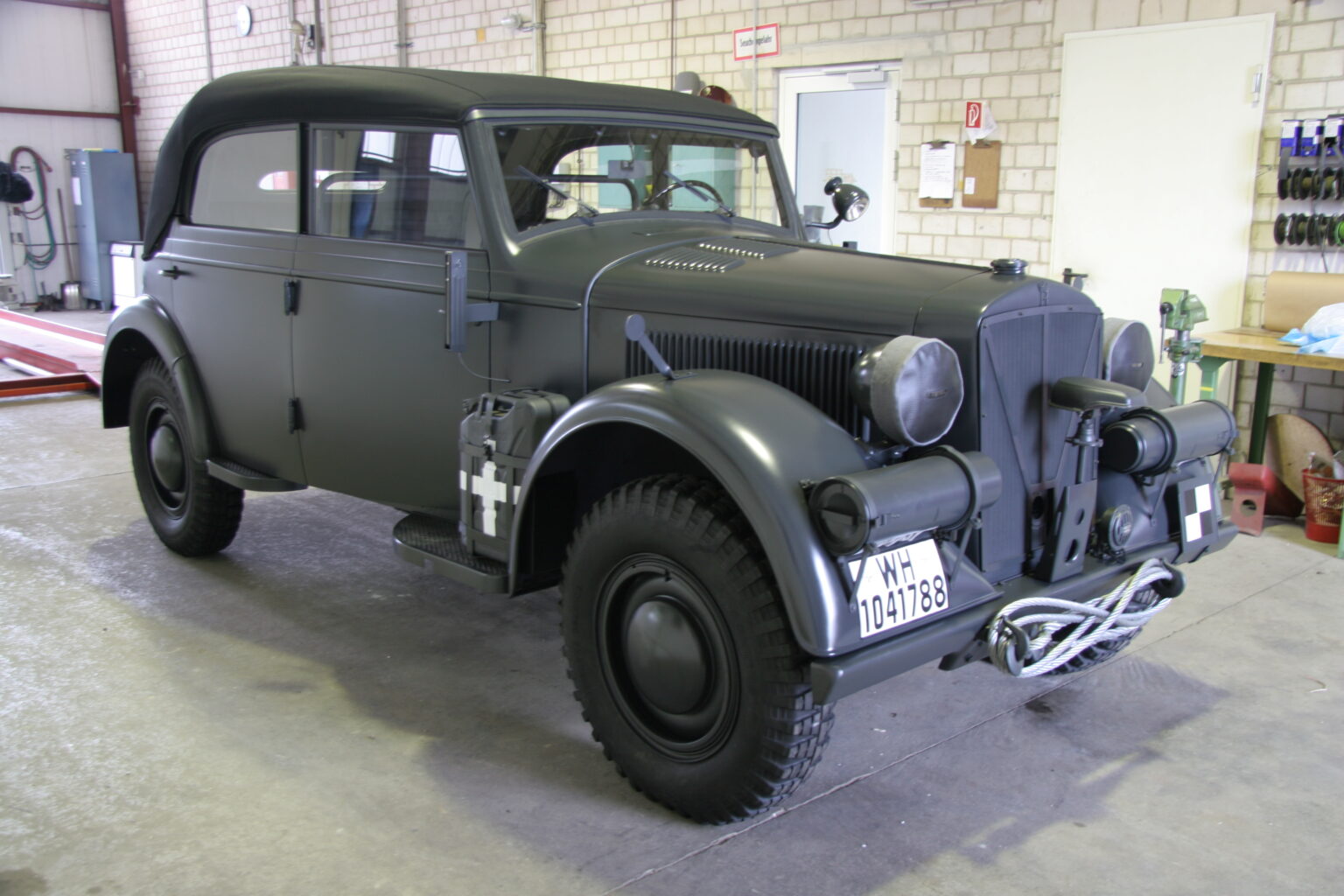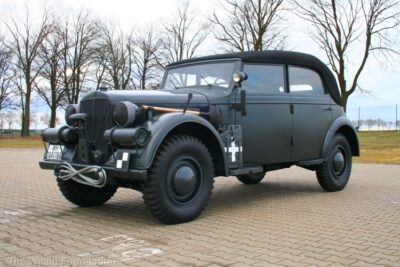In the late 1990s, we came across a German WWII staff car the Horch Kfz.21 which was in extremely poor condition. Initially, we ignored it, as we were looking for parts for our other projects, although the dealer offered it to us at a good price. Apart from recently being recovered from Nairobi, the dealer had little knowledge of the car’s history.
Known as a Kommanderwagen, this type of vehicle was generally only issued to Field Marshals or officers of Divisional rank. Only around 45 had been made. A large number of these Kommanderwagen bodies were built by the famous coachbuilders Gläser of Dresden. The primary chassis suppliers for these vehicles were Horch and Steyr of Graz in Austria. Other suppliers included Mercedes Benz and Skoda of Bohemia-Moravia.
However, we decided to purchase the Horch, as it was too good an offer to disregard and had it shipped back to the UK.
Eventually having stored the vehicle for a while, we decided to restore the Horch and appointed a Berlin-based restorer. This decision was based on the company having restored vehicles for the Audi Museum. Interestingly, Audi itself was once a subsidiary of Horch.
Over the course of the restoration, many features were discovered which led to the uncovering of a large amount of detail. Also, all the available wartime photographs of the Horch 21s were studied and reviewed. It emerged that nearly all the vehicles had different finishes both internally and externally, just to add to the restoration challenge.
In addition to the vehicle differences, many questions remained about the vehicle These included how the Horch had ended up in Kenya and its general post-war history. Nevertheless, as the project progressed, our research started to suggest that the Horch may have been issued to Field Marshal Rommel.
This Kenya angle would lead to an initial conclusion and then a later twist would emerge which would offer an alternative history for our Horch Kfz. 21 Typ 901.
During the refurbishment, it was found that repeated painting and work on the body since the end of the war had concealed many of the original details. These details comprised of such features as the mounting points for air filters and the positioning point for a Field Marshal’s steel tactical flag. The only source of information we had uncovered concerning the air filters for the carburettors, was Field Marshal Rommel’s Horch. A long list of other fixing points also matched Rommel’s Horch. The paint layers were peeled back to reveal the original paint colour, the paint shades seemed to confirm that this was a DAK (Deutsches Afrikakorps, German Africa Corps) vehicle.
An old friend within the restoration community called and told us he had received a letter describing how this vehicle had ended up in Kenya and its post-war history. It had been driven down from Libya in 1945 by a British army officer. For years, the Horch had been used at a safari lodge outside Nairobi. The car was ultimately bought by a German collector in Frankfurt.
We knew of only two Kfz.21s arriving in Africa. One had been issued to General Von Arnim and another to Rommel. Von Arnim’s vehicle was a Steyr, a totally different machine. Our Kfz.21 was a Horch and Rommel used a Horch Kfz 21.
One morning a woman turned up at the workshops claiming to know one of the Horch’s original drivers. It was well known in veteran circles that Hellmut von Leipzig was Rommel’s driver in the Western Desert. He provided us with numerous photographs and significant information regarding the specific features of the car.
At this point, we were satisfied we had correctly identified the car and resolved its history.
In October 2014, we were contacted by Norwegian researcher Jul-Sverre Haugerud. He believed our vehicle was in fact the one belonging to Generaloberst Nikolaus von Falkenhorst, former commander of German forces in wartime-occupied Norway. At first, we were sceptical, eventually, the weight of Haugerud’s research proved overwhelming.
This vehicle’s journey began in post-war Norway when it was purchased by a Norwegian car dealer called Erik Arnesen from the Norwegian government. Haugerud discovered post-war Norwegian government car registration documents which contained the Fahrgestellnummer (chassis number) 53427, an exact match with ours.
It appears that after several months of refurbishment, Erik Arnesen and his family left Norway on the 5th of January 1951 with a plan to drive to Africa. They travelled through Europe and crossed into Africa via the Straits of Gibraltar. They crossed the Sahara, apparently, the first to do so in a private family car and received a certificate to commemorate this achievement. After a trip of over 16,000 kilometres, they finally arrived in Kenya.
Over time the achievements of Arnesen and his family must have faded into history. The car a wartime German Horch, became associated with Rommel, maybe with the work of overactive local imagination. It would have been easier to drive to Kenya from Libya, than from the far north of Europe.
- This article has 834 words
- Reading time: 4 minutes
- There are no photos
Become a Member - Access the Full Article
Members gain access to the full content of our articles, including photo galleries.


